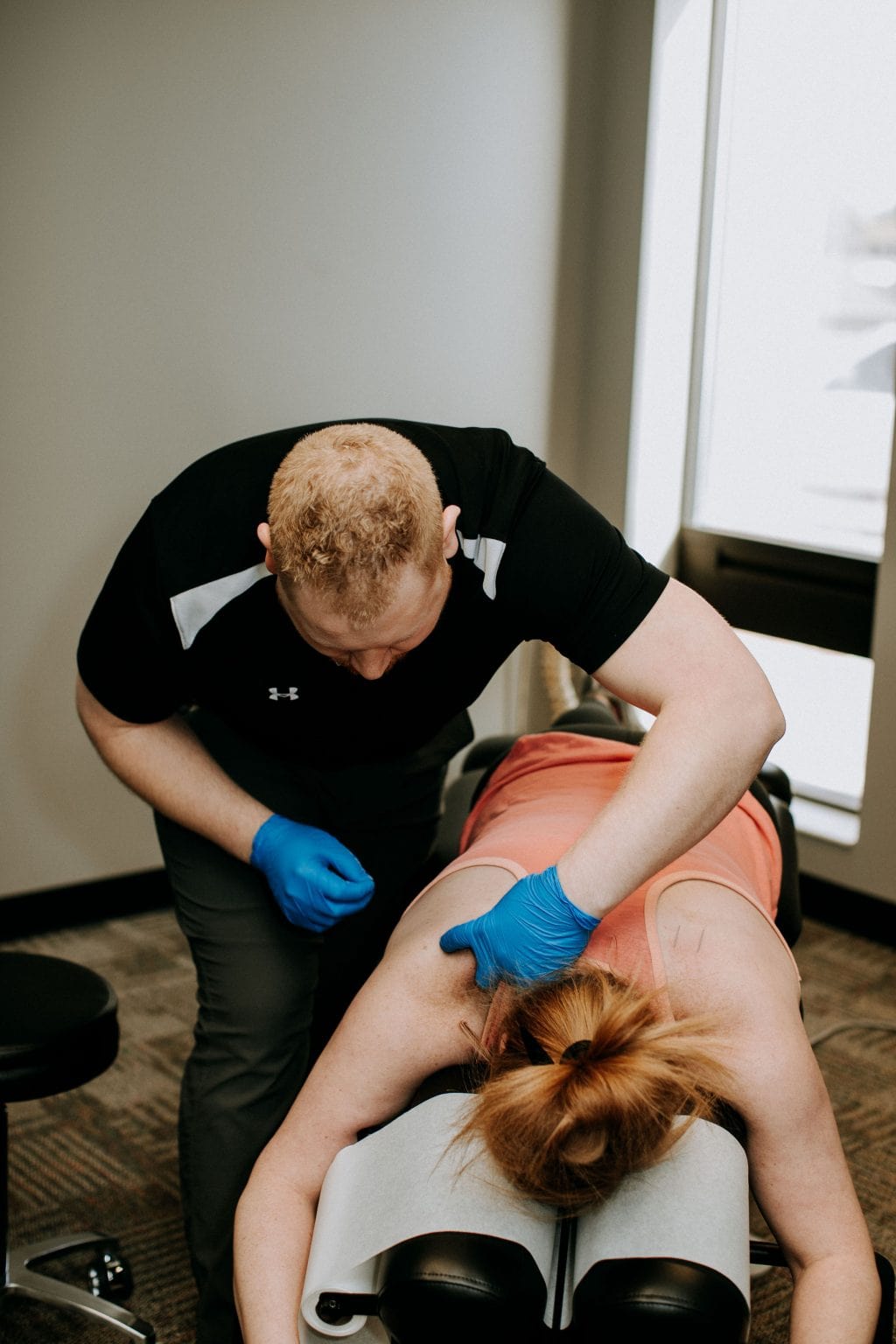Dry needling is becoming increasingly popular, causing many people to wonder, “What is dry needling?” The American Physical Therapy Association defines dry needling as “a technique used to address dysfunctions in skeletal muscle, connective tissue, and fascia, reduce or restore impairments of body structure and function resulting in improved activity and participation.” When performed by physical therapists, dry needling can reduce pain from many sources and improve the range of motion.

How does dry needling work?
Dry needling is inserting a thin, solid needle into the skin and muscle tissue and directing it towards an active or latent trigger point. A trigger point is often referred to as a muscle knot or a “tight spot” in muscular tissue. An active trigger point spontaneously causes pain, but a latent trigger point only causes pain when compressed. Trigger points, both active and latent, can limit a muscle’s ability to function and activate properly.
When a dry needle is inserted into a trigger point, the muscle has a “twitch response,” allowing it to relax. However, a twitch response is not mandatory to reduce the trigger point. Researchers discovered a change in pH and biochemical levels at muscle trigger points. When a dry needle is inserted around the trigger point, the biochemical and pH levels change, most likely causing the pain reduction.
Is Dry Needling Safe?
Yes! In the physical therapy community, dry needling is regarded as very safe. According to a recent study, the most common adverse events associated with dry needling was bleeding, bruising, and pain during treatment. According to the same study, 0.1 percent of patients had a major adverse event such as pneumothorax (collapsed lung), excessive bleeding, or prolonged aggravation.
Physical therapists that use dry needling are certified and have completed post-graduate training. A doctorate in physical therapy, passing the National Physical Therapy Exam, and extensive knowledge of the human body are all required to become a licensed physical therapist.
Different Dry Needling Techniques
- Deep Dry Needling: This technique inserts the needle directly into the trigger point. The needle is manipulated to cause a muscle twitch, and this is regularly done as long as the muscle continues to twitch or until the muscle tension decreases. Of course, the patient may request that the procedure be stopped before a change in muscle tension is felt. This technique can be performed on several trigger points in the same muscle and multiple muscles during one treatment session.
- Superficial Dry Needling: A twitch response is not sought in superficial dry needling, which is the opposite of deep dry needling. Instead, the needle is inserted into the muscle near but not at the trigger point. The needle is then left in the muscle until the muscle tension is reduced, which usually takes 30 seconds to 2 minutes. This technique, like deep dry needling, can be used on multiple muscles at the same time. When deep dry needling causes significant muscular soreness, or the patient does not like feeling a twitch response, superficial dry needling is frequently used. This technique is frequently used in dry needling to decrease scar tissue adhesions caused by surgery or injury.
- Electro Dry Needling: Two needles are inserted into or on either side of a trigger point. Electrodes are then hooked to each needle. The frequency is adjusted to prompt various responses, such as endorphin release and other chemical responses. Electro dry needling, like the other techniques, can be performed multiple times in one session and over multiple sessions.
Are there any risks or side effects of dry needling?
Dry needling, like any other treatment, has risks. However, these risks are minor compared to medicated injections or other invasive procedures. During treatment, the most common side effects of dry needling include bleeding, bruising, and pain. If a patient bleeds, it is usually very little and easily wiped away with an alcohol swab. Pneumothorax (collapsed lung), severe bleeding, and an allergic reaction to the needle are all more serious risks. As previously indicated, the rate of these serious incidents is 0.1 percent since they are easy to avoid. Dry needling certified physical therapist understands the anatomy around the lungs and can use techniques to prevent the needle from being aimed at the lung, even when dry needling neighboring muscles. Furthermore, before doing dry needling, a patient is screened for bleeding disorders, current medications, and metal allergies to assure the patient’s safety.
Is Dry Needling painful?
To some extent, yes, but not always. The pain experienced during treatment is affected by the dry needling technique and the person’s preexisting pain level. The insertion of the needle into the skin and muscle is rarely painful. It is commonly referred to as a “poke.” A muscle twitch response, which is wanted in deep dry needling, can be painful. On the other hand, superficial dry needling is frequently relaxing, not painful. Muscle soreness is to be expected after dry needling, but it should last no longer than 24 hours and can be reduced with exercise, heat, or over-the-counter pain medication if needed.
If you have any additional questions about dry needling or would like to schedule a dry needling appointment with one of our physical therapists at Elite Health and Wellness in Kearney, NE, please contact us at (308) 455 1500 or make an appointment online. We will be pleased to address any questions you may have about dry needling.

